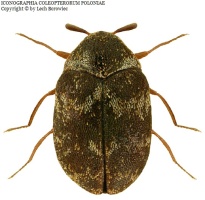
Русские, остановите эту войну! Спасите Свободную Украину!
Russians, stop this war! Save Free Ukraine!
Biodiversity Map
Taxa

Helocerus — subordinate taxa:
Taxon count: 2
-
Arthropodaphylum
Click to switch
to select orders
and filters > -
Hexapodasubphylum
Click to switch
to select orders
and filters > -
Insectaclass
Click to switch
to select orders
and filters > -
Coleopteraorder
Click to set
as the main taxon
and as a base
← of the left panel > -
Polyphagasuborder
Click to set
as the main taxon
and as a base
← of the left panel > -
Bostrichiformiaseries
Click to set
as the main taxon
and as a base
← of the left panel > -
Bostrichoideasuperfamily
Click to set
as the main taxon
and as a base
← of the left panel > -
Dermestidaefamily
Click to set
as the main taxon
and as a base
← of the left panel > -
Megatominaesubfamily
Click to set
as the main taxon
and as a base
← of the left panel > -
Anthreninitribe
Click to set
as the main taxon
and as a base
← of the left panel > -
Anthrenusgenus
Click to set
as the main taxon
and as a base
← of the left panel > -
Helocerussubgenus
Click to set
as the main taxon
and as a base
← of the left panel >
PL
YES
name status: valid name
BioMap ID: 1016468
taxon code: 3017
taxonomy checked: YES
Data on distribution in Poland

Statistics
- Records: 79
- Publications: 32
- Collections: 10
- Publication authors: 31
- Illustrations (iconography): 1
- Photos (specimen/observation): 1
Taxon description
Gatunek wykazany z zachodniej i środkowej części Europy, ze Szwecji, z Kaukazu, Azji Środkowej i Ameryki Północnej. W Polsce występuje prawdopodobnie w całym kraju, nie jest notowany jednak jeszcze z niektórych krain. Larwy spotykano w gniazdach ptaków, pod odstającą korą drzew, w domach i magazynach, gdzie żywią się wyssanymi, martwymi owadami w pobliżu poziomej sieci pająków, na przykład Tegenaria domestica (Clerck). Mogą wyrządzić szkody w zbiorach zoologicznych; notowano je również jako szkodniki przypadkowe, bez znaczenia ekonomicznego, w magazynach i domach towarowych. Postacie dojrzałe pojawiają się okresowo w maju-lipcu na rozmaitych kwiatach, przeważnie białych, gdzie żywią się nektarem i pyłkiem i gdzie ma miejsce kopulacja.
Illustrations
... browse
 Anthrenus
Anthrenusfuscus
Photos
... browse
 Anthrenus
Anthrenusfuscus
External data sources
- Ostatnie rekordy
-
1112906
 ⊡
⊡ Dermestidae: Anthrenus fuscus, PL, Wyżyna Lubelska, Lublin / Zemborzyce, UTM FB06, 1989, leg. J. Mazepa
Dermestidae: Anthrenus fuscus, PL, Wyżyna Lubelska, Lublin / Zemborzyce, UTM FB06, 1989, leg. J. Mazepa -
1112905
 ⊡
⊡ Dermestidae: Anthrenus fuscus, PL, Nizina Mazowiecka, Warszawa, UTM DC98, 2010, leg. W. Jędryczkowski
Dermestidae: Anthrenus fuscus, PL, Nizina Mazowiecka, Warszawa, UTM DC98, 2010, leg. W. Jędryczkowski -
1055711
 ⊡
⊡ Dermestidae: Anthrenus fuscus, AZ, Talysh Mountains, Lerik rayonu, ad Peştatiük, 2010, leg. A. Lasoń
Dermestidae: Anthrenus fuscus, AZ, Talysh Mountains, Lerik rayonu, ad Peştatiük, 2010, leg. A. Lasoń -
1055515
 ⊡
⊡ Dermestidae: Anthrenus fuscus, AZ, Talysh Mountains, Yardımlı rayonu, ad Yardımlı, 2010, leg. A. Lasoń
Dermestidae: Anthrenus fuscus, AZ, Talysh Mountains, Yardımlı rayonu, ad Yardımlı, 2010, leg. A. Lasoń -
1055514
 ⊡
⊡ Dermestidae: Anthrenus fuscus, AZ, Talysh Mountains, Yardımlı rayonu, ad Yardımlı, 2010, leg. A. Lasoń
Dermestidae: Anthrenus fuscus, AZ, Talysh Mountains, Yardımlı rayonu, ad Yardımlı, 2010, leg. A. Lasoń -
1055513
 ⊡
⊡ Dermestidae: Anthrenus fuscus, AZ, Talysh Mountains, Yardımlı rayonu, ad Yardımlı, 2010, leg. A. Lasoń
Dermestidae: Anthrenus fuscus, AZ, Talysh Mountains, Yardımlı rayonu, ad Yardımlı, 2010, leg. A. Lasoń -
1055434
 ⊡
⊡ Dermestidae: Anthrenus fuscus, AZ, Talysh Mountains, Yardımlı rayonu, ad Yardımlı, 2010, leg. A. Lasoń
Dermestidae: Anthrenus fuscus, AZ, Talysh Mountains, Yardımlı rayonu, ad Yardımlı, 2010, leg. A. Lasoń -
1055433
 ⊡
⊡ Dermestidae: Anthrenus fuscus, AZ, Talysh Mountains, Yardımlı rayonu, ad Yardımlı, 2010, leg. A. Lasoń
Dermestidae: Anthrenus fuscus, AZ, Talysh Mountains, Yardımlı rayonu, ad Yardımlı, 2010, leg. A. Lasoń -
771580
 ×
× Dermestidae: Anthrenus fuscus, PL, dol. Nidy, Pińczów, 1991, leg. L. Borowiec, coll. Uniw. Wrocławski, ZBiTE
Dermestidae: Anthrenus fuscus, PL, dol. Nidy, Pińczów, 1991, leg. L. Borowiec, coll. Uniw. Wrocławski, ZBiTE -
771295
 ⊡
⊡ Dermestidae: Anthrenus fuscus, PL, Nizina Wielkopolsko-Kujawska, Wielkopolska, Ruda Milicka, UTM XT61, 1989, leg. L. Borowiec, coll. Uniw. Wrocławski, ZBiTE
Dermestidae: Anthrenus fuscus, PL, Nizina Wielkopolsko-Kujawska, Wielkopolska, Ruda Milicka, UTM XT61, 1989, leg. L. Borowiec, coll. Uniw. Wrocławski, ZBiTE - ... more
- Powiązane publikacje
-
Plewa R., Jaworski T., Hilszczański J., Horák J. 2017a. Investigating the biodiversity of the forest strata: The importance of vertical stratification to the activity and development of saproxylic beetles in managed temperate deciduous forests. For. Ecol. Manage., 402:186-193.
 Show records
Show records -
Plewa R., Jaworski T., Hilszczański J. 2014b. Martwe drewno a jakościowa i ilościowa struktura chrząszczy (Coleoptera) saproksylicznych w drzewostanach dębowych. Studia i Materiały CEPL w Rogowie, 41(4):279-299.
 Show records
Show records -
Ruta R., Pacuk B., Jałoszyński P. 2011d. Nowe stanowiska rzadko spotykanych Dermestidae (Insecta: Coleoptera) w Polsce. Wiad. Entomol., 30(1):47-53.
 full text
full text Show records
Show records -
Ruta R., Konwerski Sz., Królik R., Lasoń A., Miłkowski M. 2006a. Nowe stanowiska skórnikowatych (Coleoptera: Dermestidae) w Polsce. Część 2. Megatominae. Wiad. Entomol., 25(1):21-28.
 full text
full text Show records
Show records -
Kadej M. 2005. Dane o występowaniu przedstawicieli Dermestidae (Coleoptera) w Polsce. Wiad. Entomol., 24(1):21-31.
 full text
full text Show records
Show records - ... more






